智能散热器的设计
基于单片机的笔记本电脑智能底座设计论文

摘要笔记本电脑,便于携带,体积小,而且它的功能满足大多数人的需要,随着科学技术的近步带来的成本下降,笔记本的价格也为大多数人所接受。
随着使用笔记本人数的增加,笔记本的各种问题也暴露出来,除了性价比之外,最关心的莫过于散热。
笔记本在性能与便携性对抗中,散热成为最关键的因素,笔记本散热一直是笔记本核心技术中的瓶颈。
有时笔记本电脑会意外的死机,一般就是系统温度过高导致。
为了解决这个问题,人们设计了散热底座,可以使笔记本产生的热量尽快的扩散到电脑外部,不影响笔记本的使用功能,不会使电脑的线路出现腐蚀现象,保证笔记本电脑的正常工作。
好的底座可以很大的延长笔记本电脑使用寿命。
本设计针对散热问题做了深入的探讨,并设计出一套基于单片机控制的智能散热底座,综合了成本和性能等相关因素,采用了Atmel公司的AT89S52为核心搭建了该系统。
在本着成本控制和推向市场的前提下,文中的电路简约而易于批量生产,在完成散热功能和最少成本的前提下达到了节能和智能。
关键词:散热底座;单片机;智能控制1引言1.1系统研究背景笔记本电脑,便于携带,而且它的功能满足大多数人的需要,随着技术的近步带来的成本下降,笔记本的价格也为大多数人所接受。
随着使用笔记本人数的增加,笔记本的各种问题也暴露出来,其中散热问题至关重要,它不仅关系着能耗更关系着笔记本的使用寿命。
因此散热成为最关键的因素,笔记本散热一直是笔记本核心技术中的瓶颈。
有时笔记本电脑会莫名奇妙的死机,一般就是系统温度过高导致。
为了解决这个问题,人们设计了散热底座,可以使笔记本产生的热量尽快的扩散到电脑外部,不影响笔记本的使用功能,保证笔记本电脑的正常工作。
而目前市场上仅仅有的是单开关式的散热器,且操作不方便,经常开关,还没有根据温度变化来进行控制的智能散热底座。
1.2散热原理和方式散热,其实就是一个热量传递过程通过传导、对流、辐射等几种方式。
通常在台式机中主要是风冷技术,这包括中央处理器、显卡、电源及机箱的散热风扇等,在笔记本电脑中,风冷依旧的主要的散热方式,绝大数的散热方式是:风扇、热管、散热板的组合。
智能温控散热器设计—毕业设计
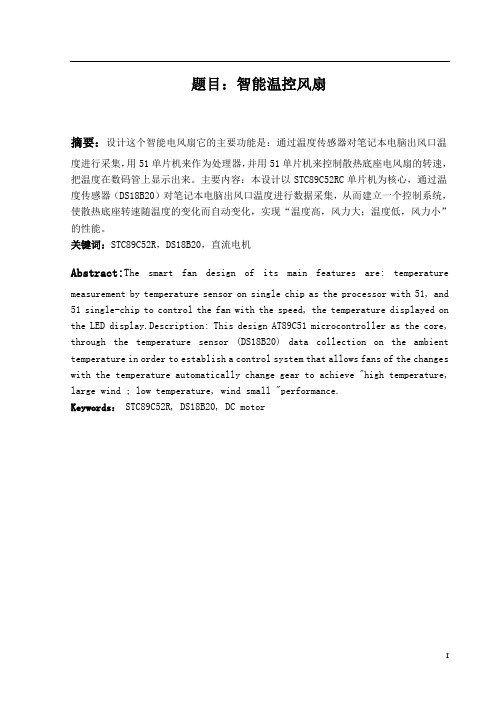
题目:智能温控风扇摘要:设计这个智能电风扇它的主要功能是:通过温度传感器对笔记本电脑出风口温度进行采集,用51单片机来作为处理器,并用51单片机来控制散热底座电风扇的转速,把温度在数码管上显示出来。
主要内容:本设计以STC89C52RC单片机为核心,通过温度传感器(DS18B20)对笔记本电脑出风口温度进行数据采集,从而建立一个控制系统,使散热底座转速随温度的变化而自动变化,实现“温度高,风力大;温度低,风力小”的性能。
关键词:STC89C52R,DS18B20,直流电机Abstract:T he smart fan design of its main features are: temperature measurement by temperature sensor on single chip as the processor with 51, and 51 single-chip to control the fan with the speed, the temperature displayed on the LED display.Description: This design AT89C51 microcontroller as the core, through the temperature sensor (DS18B20) data collection on the ambient temperature in order to establish a control system that allows fans of the changes with the temperature automatically change gear to achieve "high temperature, large wind ; low temperature, wind small "performance.Keywords:STC89C52R, DS18B20, DC motor目录第一章整体方案设计 (1)1.1 前言 (1)1.2 系统整体设计 (1)1.3 方案论证 (2)1.3.1 温度传感器的选择 (2)1.3.2 控制核心的选择 (3)1.3.3 温度显示器件的选择 (3)1.3.4 调速方式的选择 (4)第二章各单元模块的硬件设计 (5)2.1系统器件简介 (5)2.1.1 DS18B20单线数字温度传感器简介 (5)2.1.2 达林顿反向驱动器ULN2803简介 (5)2.1.3 STC89C52RC单片机简介 (5)2.1.4 LED数码管简介 (6)2.2 各部分电路设计 (6)2.2.1 开关复位与晶振电路 (6)2.2.2 独立键盘连接电路 (7)2.2.3 数码管显示电路 (7)2.2.4 温度采集电路 (8)2.2.5 风扇电机驱动与调速电路 (8)2.2.6串口通信 (9)第三章软件设计 (10)3.1 程序设置 (10)3.2 用Keil C51编写程序 (11)第四章系统调试 (12)4.1 软件调试 (12)4.2 硬件调试 (12)4.2.1 数码管亮度明显偏低 (12)4.2.2 传感器DS18B20温度采集部分调试 (12)4.2.3 电动机调速电路部分调试 (13)4.3 系统功能 (13)4.3.1 系统实现的功能 (13)4.3.2 系统功能分析 (13)结论 (14)参考文献 (15)致谢 (16)附录1:电路总图 (17)附录2:程序设计 (18)第一章整体方案设计1.1 前言在现代社会中,风扇被广泛的应用,发挥着举足轻重的作用,如夏天人们用的散热风扇、工业生产中大型机械中的散热风扇以及现在笔记本电脑上广泛使用的智能CPU风扇等。
CPU散热器的热导管与散热风扇结构设计

CPU散热器的热导管与散热风扇结构设计随着电子设备性能的提高和使用功率的增加,CPU的散热问题变得愈发突出。
在现代计算机中,CPU散热器是保证处理器正常工作的重要组成部分。
本文将探讨CPU散热器中热导管与散热风扇的结构设计,旨在解决CPU散热问题。
热导管在CPU散热器中扮演着重要的角色。
它主要通过热传导的方式将热量从CPU导出,提高散热效果。
热导管的设计应考虑以下几个方面:其一,热导管材料的选择。
优秀的热导管材料应具备高热导率和良好的强度,以确保热导管的导热效率和使用寿命。
铜和铝是常用的热导管材料,它们具有良好的热导率和较高的强度,适合作为热导管的制材。
其二,热导管的结构。
热导管一般由内外两层金属管组成,中间填充工质。
热传导过程中,CPU产生的热量使工质在内外两层金属管之间发生相变,从而实现热量的传递。
优化热导管的结构设计,可以提高热量的传导效率。
例如,增加内层金属管的表面粗糙度,可以增大与工质的接触面积,提升热传导速率。
其三,热导管的连接方式。
热导管需要与CPU的散热表面接触,以充分传导热量。
常见的连接方式有焊接和热导胶粘结。
焊接方式能够保证良好的热接触性,但一旦固定,难以更换。
而采用热导胶粘结可以灵活更换热导管,但热接触性可能略有降低。
热导管是CPU散热器中的重要组成部分,但单靠热导管无法将导出的热量迅速散尽,因此需要配合散热风扇进行散热。
散热风扇作为CPU散热器的另一重要组成部分,其结构设计应满足以下要求:首先,散热风扇的转速应根据处理器的发热量进行调配。
过低的转速无法充分散热,过高的转速则会增加噪音和功耗。
通过智能控制,根据CPU的温度动态调整散热风扇的转速,可以在保证散热效果的同时减小噪音和功耗。
其次,散热风扇的叶片设计应具备较好的风量和压力特性。
为了达到更好的散热效果,增大散热风扇的风量是必要的。
然而,增大风量会带来更大的风阻,降低空气压力。
因此,叶片的曲线设计需要考虑到风量和风压之间的平衡,提高散热风扇的效率。
压铸铝散热器施工方案设计

压铸铝散热器施工方案设计一、方案背景随着电子设备的发展和智能化程度的提高,电子产品的散热问题愈发突出。
而在电子产品的散热方案中,压铸铝散热器由于其材料优势和制造工艺特点,成为了广泛应用的热管理解决方案之一。
本文旨在针对压铸铝散热器的施工方案进行设计。
二、施工流程1.原材料准备:选择合适的压铸铝材料,按照设计需求进行采购。
同时准备相应的模具和工艺设备。
2.模具制备:根据散热器的设计要求,制作相应的压铸模具。
模具制备完成后进行检查和调试,确保其正常可用。
3.材料熔化:将压铸铝材料加入铝熔炉中进行熔化,并根据需要添加合适的合金元素,以提升散热器的性能。
4.压铸过程:将熔化的铝液注入模具中,利用高压使其充分填充整个模具腔体,并形成预定的散热器形状。
5.除渣处理:待铝液冷却固化后,对散热器进行除渣处理,以去除表面的气孔和杂质,提高表面质量和散热性能。
6.表面处理:根据设计要求,对散热器进行表面处理,如喷涂、阳极氧化等,提升产品的外观和耐腐蚀性。
7.检验和测试:对加工完成的散热器进行检验和测试,确保其符合设计要求和性能指标。
三、施工注意事项1.模具设计:模具的合理设计对于散热器的质量和生产效率至关重要,要确保模具结构合理、软硬件配置适当以及模具寿命长。
2.材料选择:根据散热器的具体需求,选择合适的压铸铝材料和合金元素,以确保散热器具备良好的热导性和机械性能。
3.压铸工艺控制:在压铸过程中,需要控制好铝液的注入速度、温度和压力等参数,以保证散热器的成型质量。
4.除渣处理:除渣处理是确保散热器表面质量的关键步骤,需要选择适当的除渣方法和设备,严格按照工艺规范进行操作。
5.表面处理:表面处理工艺对于散热器的外观和耐腐蚀性能起着重要作用,要选择适当的处理方法,并注意控制处理时间和温度。
6.检验和测试:对散热器的检验和测试要严格按照相关标准进行,确保散热器满足设计要求和性能指标。
四、施工成本与效益压铸铝散热器的施工成本主要包括原材料采购、模具制备、设备投资和人工费用等方面。
关于散热器密封结构的设计及解析

散热器是一种常见的热管理设备,它通常用于电子设备中,以帮助散热并保持设备的温度稳定。
而密封结构对散热器的性能和稳定性起着至关重要的作用。
本文将围绕散热器密封结构的设计和解析展开讨论,并就其影响因素、设计原则以及未来发展方向进行深入探讨。
1. 密封结构的影响因素散热器的密封结构受到多种因素的影响,首先是环境因素。
如果散热器需要在高温或潮湿环境中工作,密封结构需要具备防水、耐高温等特性。
其次是材料因素,密封结构的材料选择将直接影响其密封性能和耐久性。
另外,安装方式、结构设计、制造工艺等因素也会对密封结构的性能产生影响。
2. 密封结构的设计原则在设计散热器的密封结构时,需要遵循一些基本原则。
首先是密封性原则,即要求密封结构能够有效地隔绝外部环境,并保持内部气流的稳定。
其次是耐久性原则,密封结构需要具备长期稳定工作的能力,尤其是在恶劣环境下。
密封结构的设计还需要考虑安装和维护的便利性,以及成本和制造工艺等因素。
3. 密封结构的未来发展随着科技的不断发展,散热器密封结构也在不断更新换代。
未来,随着材料技术的进步,新型的密封材料将被应用于散热器的设计中,以提高其密封性能和耐久性。
基于人工智能和大数据技术的智能化密封结构设计和监测系统也将逐渐成熟,为散热器的性能优化提供更加可靠的技术支持。
4. 个人观点和总结从我个人的角度来看,散热器的密封结构设计是一个非常重要的环节,它直接影响着散热器的工作效果和稳定性。
在未来,我期待看到更多的创新技术被应用于散热器密封结构的设计中,以进一步提高散热器的性能表现。
通过对散热器密封结构的设计和解析,我们不仅能够更深入地理解散热器的工作原理和性能表现,也能够为未来散热器的设计和应用提供更多的思路和参考。
希望本文能够对读者有所启发,也期待在未来能够见证散热器技术的不断进步与发展。
散热器密封结构在电子设备中的应用越来越广泛,其性能和稳定性对设备的工作效果起着至关重要的作用。
设计和优化散热器的密封结构是一个非常重要的课题。
手机智能散热器设计

手机智能散热器设计作者:张翰林隋晓莹来源:《工业设计》2021年第08期关键词:手机;智能;散热器设计1 研究背景在手机使用过程中,手机机体发热是大多数手机使用者需要面对的共同问题。
智能手机包含了许多能产生热量的部件,以及因为受热导致性能与使用方法不良而造成部件损坏。
其中,处理器是产生热量的主要部件,其他能够产生大量热量的部件还有锂离子电池、图像传感器、光源等。
手机发热的原因大多是手机通话时间过长、下载文件、运行游戏软件或者充电时产生大量热量等。
而手机发热则会导致手机信号不稳定、运行卡顿、电路老化加快、电池续航减弱、使用寿命缩短等问题发生,造成使用者安全性和舒适性的降低,以及维修费用上的经济损失[1]。
近年来,随着智能科技的稳定发展,智能制造已经成为诸多产品研发的重点,推进智能制造技术可以有效地提高产品的工作效率,以及降低其运行成本,因此在手机散热器方面,可以寻找一些升级的突破口,比如运用特定的装置来实现智能控温[2]。
在智能手机进入5G 时代后,手机的使用频率增多,其配件必将承受更大的使用压力,因此我们应当尽力排除外界因素的影响,以延长手机的使用寿命[3-4]。
目前国内大部分的手机散热器都无法有效解决以上困难,且同时存在噪音大、体积大且散热效率低的问题,导致大多数散热器使用者不再购买手机散热器,使得手机散热器市场越来越局限。
2 研究意义研究的意义在于加快手机散热效率,减少手机散热器体积来保证产品的实用性与便携性,并结合相关的技术和知识,达到高温感应、及时降温的目的,给产品使用者带来良好的手机使用环境。
3 手机智能散热器设计思路手机智能散热器设计的思路是在散热器中加入无线温度传感装置,感知手机温度,并实时向手机传送温度数据,让使用者通过配套APP 实时监测到手机的温度,自行选择是否开启散热器的降温模式。
同时,将它的散热模式分为先后两个步骤:当散热器感应到手机温度上升到一定程度时,散热器先自动开启冷夹散热系统进行手机的高温冷却处理,在温度降低到设定的正常值后再启动离心风扇持续恒定的降温。
散热技术的技术路线
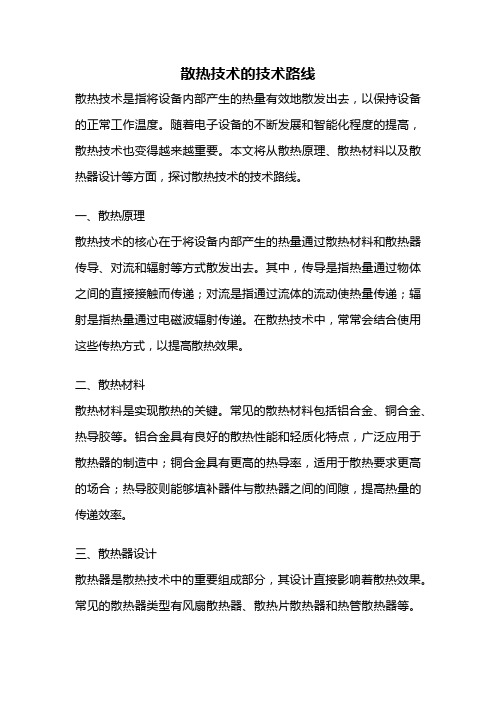
散热技术的技术路线散热技术是指将设备内部产生的热量有效地散发出去,以保持设备的正常工作温度。
随着电子设备的不断发展和智能化程度的提高,散热技术也变得越来越重要。
本文将从散热原理、散热材料以及散热器设计等方面,探讨散热技术的技术路线。
一、散热原理散热技术的核心在于将设备内部产生的热量通过散热材料和散热器传导、对流和辐射等方式散发出去。
其中,传导是指热量通过物体之间的直接接触而传递;对流是指通过流体的流动使热量传递;辐射是指热量通过电磁波辐射传递。
在散热技术中,常常会结合使用这些传热方式,以提高散热效果。
二、散热材料散热材料是实现散热的关键。
常见的散热材料包括铝合金、铜合金、热导胶等。
铝合金具有良好的散热性能和轻质化特点,广泛应用于散热器的制造中;铜合金具有更高的热导率,适用于散热要求更高的场合;热导胶则能够填补器件与散热器之间的间隙,提高热量的传递效率。
三、散热器设计散热器是散热技术中的重要组成部分,其设计直接影响着散热效果。
常见的散热器类型有风扇散热器、散热片散热器和热管散热器等。
风扇散热器通过风扇的转动产生气流,增强对流散热效果;散热片散热器利用大面积的散热片增加散热面积,提高散热效率;热管散热器则通过热管的工作原理将热量传导到散热片上,实现高效散热。
四、散热技术的发展趋势随着电子设备的不断发展和性能的提升,对散热技术的要求也越来越高。
未来的散热技术将朝着以下几个方向发展:1. 散热材料的优化:研发更高导热性能的散热材料,如石墨烯等,以提高散热效果。
2. 散热器结构的创新:设计更加紧凑、高效的散热器结构,减小设备体积的同时提高散热效率。
3. 液态散热技术的应用:利用液态冷却剂进行散热,提高散热效果,同时降低噪音和能耗。
4. 相变材料的利用:利用相变材料的相变过程吸收和释放大量热量,实现高效散热。
5. 智能化散热控制:通过传感器和控制系统实时监测设备的温度和负载情况,调整散热风扇的转速和散热器的工作状态,实现精确的散热控制。
一种新型智能静音液冷CPU散热器
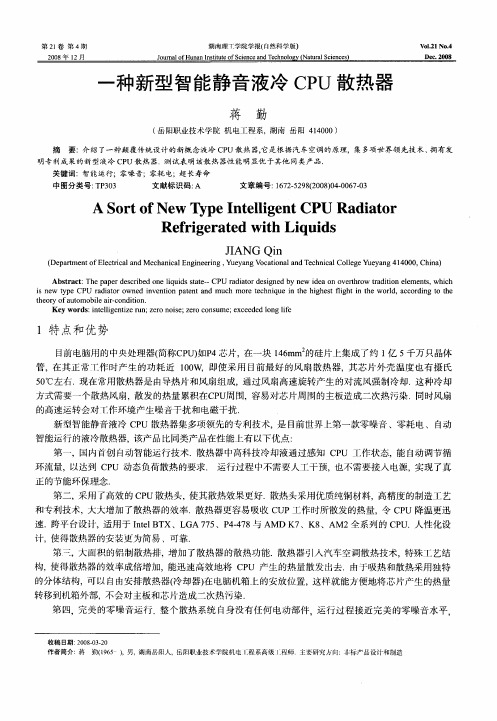
20 0 8年 1 2月
湖 南理 T学 院学 报( 自然 科 学版)
J u a f n n I si t fS i n ea dTe h olg Na u a ce c s o m l a t u eo ce c n c n o y( t r l in e o Hu n t S
5 ℃左右. 0 现在常用散热器是 由导热片和风扇组成, 通过风扇高速旋转产生 的对流风强制冷却. 这种冷却
方式 需要 一个 散热 风扇 ,散发 的 热量 累积 在C U 围,容易 对芯 片周 同的主 板造 成二 次热 污染 .同时风扇 P周
的高速运 转会对 T作 环境 产 生噪音 干扰 和 电磁 干扰 . 新 型 智能静 音液 冷 C U 散热 器集 多项 领先 的专 利技 术 , 目前 世界 上第 一 款零 噪音 、零耗 电 、 自动 P 是 智能运 行 的液冷 散热 器,该 产品 比同类 产 品在性 能 上有 以下 优点 : 第 一 ,国 内首 创 自动智 能运 行技 术 . 热 器 中高科 技冷 却液 通 过感 知 C U 二 作状 态 ,能 自动 调 节循 散 P r 环 流量 ,以达 到 C U 动态 负荷 散热 的要 求 . 运 行 过程 中不 需要 人工 干预 ,也不需 要 接入 电源 ,实现 了真 P
A o to w y eI t l g n S r f Ne T p n el e tCPU d a o i Ra i t r
Re rg r t d wih Li u d fie a e t q i s
JA I NG n Qi
( e a met f l tcl n ca i l n i eig, uy n o ai a adT cncl olg u y n 10 0 C ia D p r n Ee r a adMehnc gn r t o ci aE e n Y ea g ct n l n eh i l e e ag4 4 0 , hn ) V o aC e Y
显卡的散热器设计和风扇控制
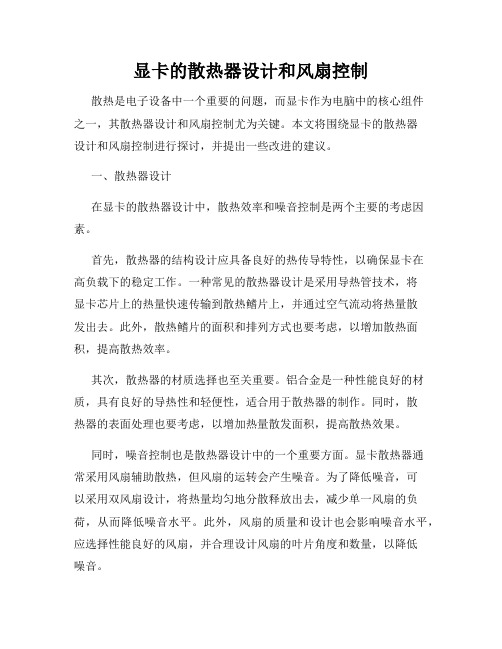
显卡的散热器设计和风扇控制散热是电子设备中一个重要的问题,而显卡作为电脑中的核心组件之一,其散热器设计和风扇控制尤为关键。
本文将围绕显卡的散热器设计和风扇控制进行探讨,并提出一些改进的建议。
一、散热器设计在显卡的散热器设计中,散热效率和噪音控制是两个主要的考虑因素。
首先,散热器的结构设计应具备良好的热传导特性,以确保显卡在高负载下的稳定工作。
一种常见的散热器设计是采用导热管技术,将显卡芯片上的热量快速传输到散热鳍片上,并通过空气流动将热量散发出去。
此外,散热鳍片的面积和排列方式也要考虑,以增加散热面积,提高散热效率。
其次,散热器的材质选择也至关重要。
铝合金是一种性能良好的材质,具有良好的导热性和轻便性,适合用于散热器的制作。
同时,散热器的表面处理也要考虑,以增加热量散发面积,提高散热效果。
同时,噪音控制也是散热器设计中的一个重要方面。
显卡散热器通常采用风扇辅助散热,但风扇的运转会产生噪音。
为了降低噪音,可以采用双风扇设计,将热量均匀地分散释放出去,减少单一风扇的负荷,从而降低噪音水平。
此外,风扇的质量和设计也会影响噪音水平,应选择性能良好的风扇,并合理设计风扇的叶片角度和数量,以降低噪音。
二、风扇控制风扇控制是显卡散热系统中的关键环节,可以根据显卡的温度情况智能调节风扇的转速,以达到最佳的散热效果和噪音控制。
在风扇控制方面,可以采用两种方式:传感器反馈控制和软件控制。
传感器反馈控制方式是通过在显卡上安装温度传感器,实时监测显卡芯片的温度情况,并根据预设的温度范围和转速曲线,自动调节风扇的转速。
这种方式可以实现快速响应和较高的精度,但需要在显卡设计阶段进行硬件布置。
软件控制方式是通过显卡驱动软件或第三方软件,调节风扇的转速。
用户可以根据自己的需求,在软件中设置风扇转速和温度曲线,以满足自己对散热和噪音的要求。
这种方式灵活性较高,但需要保证软件的兼容性和稳定性。
对于风扇控制而言,还可以考虑风扇启停技术。
智能散热器培训课件
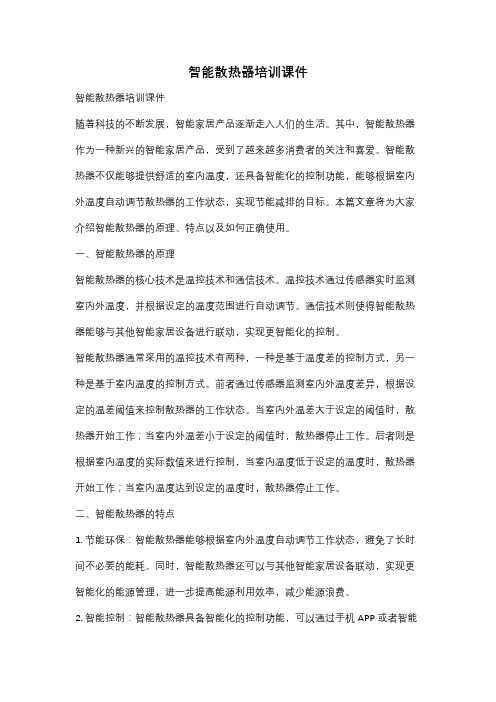
智能散热器培训课件智能散热器培训课件随着科技的不断发展,智能家居产品逐渐走入人们的生活。
其中,智能散热器作为一种新兴的智能家居产品,受到了越来越多消费者的关注和喜爱。
智能散热器不仅能够提供舒适的室内温度,还具备智能化的控制功能,能够根据室内外温度自动调节散热器的工作状态,实现节能减排的目标。
本篇文章将为大家介绍智能散热器的原理、特点以及如何正确使用。
一、智能散热器的原理智能散热器的核心技术是温控技术和通信技术。
温控技术通过传感器实时监测室内外温度,并根据设定的温度范围进行自动调节。
通信技术则使得智能散热器能够与其他智能家居设备进行联动,实现更智能化的控制。
智能散热器通常采用的温控技术有两种,一种是基于温度差的控制方式,另一种是基于室内温度的控制方式。
前者通过传感器监测室内外温度差异,根据设定的温差阈值来控制散热器的工作状态。
当室内外温差大于设定的阈值时,散热器开始工作;当室内外温差小于设定的阈值时,散热器停止工作。
后者则是根据室内温度的实际数值来进行控制,当室内温度低于设定的温度时,散热器开始工作;当室内温度达到设定的温度时,散热器停止工作。
二、智能散热器的特点1. 节能环保:智能散热器能够根据室内外温度自动调节工作状态,避免了长时间不必要的能耗。
同时,智能散热器还可以与其他智能家居设备联动,实现更智能化的能源管理,进一步提高能源利用效率,减少能源浪费。
2. 智能控制:智能散热器具备智能化的控制功能,可以通过手机APP或者智能家居中心进行远程控制。
用户可以根据自己的需求,随时随地地调节散热器的工作状态,实现个性化的温控体验。
3. 安全可靠:智能散热器采用高品质的材料和先进的制造工艺,具备良好的散热性能和耐用性。
同时,智能散热器还具备过温保护和防干烧功能,能够有效预防安全事故的发生。
三、如何正确使用智能散热器1. 合理设置温度:在使用智能散热器时,应根据实际需要合理设置温度。
如果室内温度过高,可以适当调高温度;如果室内温度过低,可以适当调低温度。
汽车散热器的毕业设计论文

汽车散热器的毕业设计论文首先,汽车散热器的设计需要考虑的要素有很多。
其中最重要的是散热器的换热效率、尺寸和重量。
换热效率是散热器最重要的指标之一,它决定了散热器能否有效地将热量散发出去。
尺寸和重量则直接关系到整个汽车的空间利用和重量控制。
因此,在设计散热器时需要在这些指标之间进行平衡和折衷,以满足汽车的需求。
其次,现代汽车散热器主要有两种类型:水冷散热器和气冷散热器。
水冷散热器是通过循环冷却剂来将热量带走的,而气冷散热器则是通过自然或强制对流将热量散发到空气中的。
两者在换热效率和使用成本上有一定的差异。
在实际设计中,根据汽车的特点和使用情况来选择合适的散热器类型。
然后,散热器的材料也是设计中需要考虑的重要因素。
常见的散热器材料有铝合金和铜合金。
铝合金具有优异的导热性和轻质化的优点,但强度相对较低。
铜合金则具有较高的强度,但相对较重。
在材料选择上需要权衡导热性、重量和成本等因素。
此外,散热器的设计还需要考虑流体动力学和气流分析。
通过研究流体力学和气流分析,可以确定散热器内的流动状态和热交换效果,进而优化散热器的结构和形状。
同时,还需要考虑如何将气流引导到散热器中,以提高散热效率。
最后,对于汽车散热器的未来发展,可以从设计材料、换热效率和智能化等方面进行展望。
例如,可以采用新型散热材料,提高散热器的换热效率和轻量化程度。
同时,可以通过智能化设计和优化控制算法,提高散热器的响应速度和稳定性。
综上所述,汽车散热器的设计是一个复杂的工程问题,需要综合考虑多种因素。
通过合理的设计和优化,可以提高散热器的换热效率,减轻汽车发动机的负荷,从而提高汽车的性能和可靠性。
未来的发展方向是继续研究新材料和智能化技术,以提高散热器的性能和效益。
散热器的噪音控制与改善方法

散热器的噪音控制与改善方法引言:散热器是今天大多数电子设备中不可或缺的一部分。
然而,随着电子设备的不断发展,散热器常常产生噪音,给用户带来不便。
因此,控制和改善散热器噪音已成为许多制造商和用户关心的问题。
本文将介绍一些控制和改善散热器噪音的方法。
1. 优化散热器设计在散热器设计过程中,合理的流体动力学设计可以降低噪音水平。
首先,通过增加散热片的数量和减小散热片间距,可以有效增加热量的传导面积,提高散热效果,并减少噪音产生。
其次,可以采用更大的风扇和更高的转速,以便在相同散热效果下减小风扇叶片的负荷,减少噪音。
2. 选择低噪音风扇风扇是散热器中产生噪音的主要部件之一。
在选择风扇时,应尽量选择低噪音的型号。
一般来说,风扇的噪音级别与其转速和叶片设计有关。
较低的转速和优化的叶片设计可以降低噪音水平。
此外,电子设备制造商也可以寻找具有低噪音风扇的替代选项,以进一步改善用户体验。
3. 使用隔音材料在电子设备中,使用隔音材料来减少散热器噪音是另一种有效的方法。
可以在散热器和周围散热器之间添加隔音材料,以阻止噪音传播。
隔音材料通常采用密封材料,如橡胶或泡沫塑料,具有良好的隔音效果。
此外,在电子设备的外壳上添加隔音材料,也可以有效地降低从散热器中产生的噪音。
4. 控制散热器转速散热器的转速与噪音水平密切相关。
通过控制散热器的转速,可以有效减少噪音。
对于一些先进的电子设备,可以采用智能散热器控制系统,根据温度和负载情况调整风扇转速。
这样可以在保证散热效果的同时,降低噪音水平。
5. 定期清洁和维护散热器积聚的灰尘和污垢也会导致噪音水平升高。
定期清洁和维护散热器可以有效地降低噪音,并提高散热效果。
对于一些容易积灰的散热器,可以考虑增加滤网,以防止灰尘进入风扇和散热片。
结论:散热器的噪音控制和改善是电子设备制造商和用户共同关注的问题。
通过优化设计、选择低噪音风扇、使用隔音材料、控制转速以及定期清洁和维护,可以有效降低散热器的噪音水平,提供更好的使用体验。
产品结构散热要求和标准
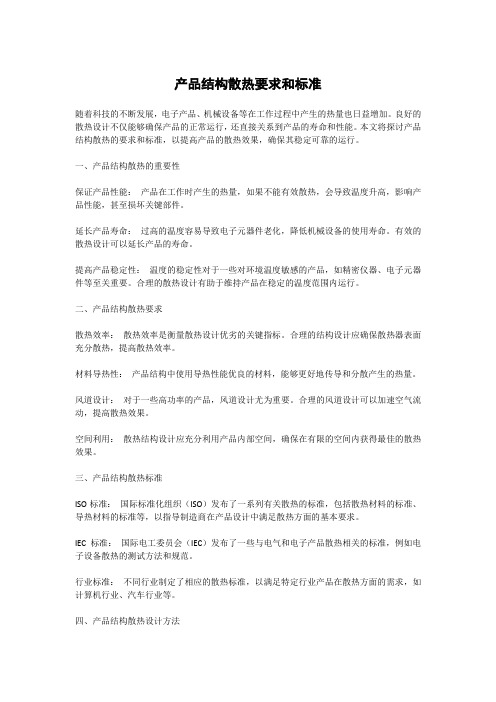
产品结构散热要求和标准随着科技的不断发展,电子产品、机械设备等在工作过程中产生的热量也日益增加。
良好的散热设计不仅能够确保产品的正常运行,还直接关系到产品的寿命和性能。
本文将探讨产品结构散热的要求和标准,以提高产品的散热效果,确保其稳定可靠的运行。
一、产品结构散热的重要性保证产品性能:产品在工作时产生的热量,如果不能有效散热,会导致温度升高,影响产品性能,甚至损坏关键部件。
延长产品寿命:过高的温度容易导致电子元器件老化,降低机械设备的使用寿命。
有效的散热设计可以延长产品的寿命。
提高产品稳定性:温度的稳定性对于一些对环境温度敏感的产品,如精密仪器、电子元器件等至关重要。
合理的散热设计有助于维持产品在稳定的温度范围内运行。
二、产品结构散热要求散热效率:散热效率是衡量散热设计优劣的关键指标。
合理的结构设计应确保散热器表面充分散热,提高散热效率。
材料导热性:产品结构中使用导热性能优良的材料,能够更好地传导和分散产生的热量。
风道设计:对于一些高功率的产品,风道设计尤为重要。
合理的风道设计可以加速空气流动,提高散热效果。
空间利用:散热结构设计应充分利用产品内部空间,确保在有限的空间内获得最佳的散热效果。
三、产品结构散热标准ISO标准:国际标准化组织(ISO)发布了一系列有关散热的标准,包括散热材料的标准、导热材料的标准等,以指导制造商在产品设计中满足散热方面的基本要求。
IEC标准:国际电工委员会(IEC)发布了一些与电气和电子产品散热相关的标准,例如电子设备散热的测试方法和规范。
行业标准:不同行业制定了相应的散热标准,以满足特定行业产品在散热方面的需求,如计算机行业、汽车行业等。
四、产品结构散热设计方法仿真模拟:利用计算机辅助设计软件进行热仿真模拟,优化散热结构,提前发现潜在的热问题。
热导管应用:在结构设计中加入热导管,将热量快速传导到散热器表面,提高散热效率。
风冷散热:通过设计风扇和散热片等结构,提高空气流通,加速散热过程。
数据中心散热系统

数据中心散热系统具有高效、可靠、 安全和节能等特点,能够确保数据中 心设备正常运行,延长设备使用寿命 ,提高数据中心的运行效率。
数据中心散热系统的重要性
数据安全
适宜的温度和湿度是保证数据中 心设备正常运行的前提,散热系 统能够防止设备过热引起的故障
和数据丢失。
能耗管理
散热系统是数据中心能耗的主要组 成部分之一,高效的散热系统能够 降低数据中心的能耗,节约能源成 本。
智能电源管理
通过智能电源管理技术,实现电源的合理分配和利用,降低能耗。
数据中心环境监控系统
建立数据中心环境监控系统,对数据中心内的环境参数进行实时监 测和记录,为辅助设备的性能提升提供数据支持。
06
数据中心散热系统案例研究
案例一:大型数据中心散热系统设计
总结词
高效、稳定、可扩展
详细描述
大型数据中心散热系统设计需要考虑多个因 素,包括设备布局、气流组织、散热方式等 。设计时需要充分考虑数据中心的规模和业 务需求,确保系统能够高效稳定地运行,并 且具备可扩展性,以满足未来业务增长的需 求。
提高监控准确度
高精度传感器
01
采用高精度传感器,实时监测数据中心内的温度、湿度等参数
。
数据采集与处理
02
通过数据采集与处理技术,对监测数据进行实时分析,提高监
控准确度。
报警与故障诊断
03
设置报警与故障诊断功能,及时发现并处理异常情况,确保数
据中心安全稳定运行。
增强辅助设备性能
高性能UPS电源
配备高性能的UPS电源,确保数据中心在电力故障时能够正常运 行。
智能控制
通过智能控制技术,实时监测和调整散热系统运行状态,实现散热 效率的优化。
一款多功能智能散热器的结构设计
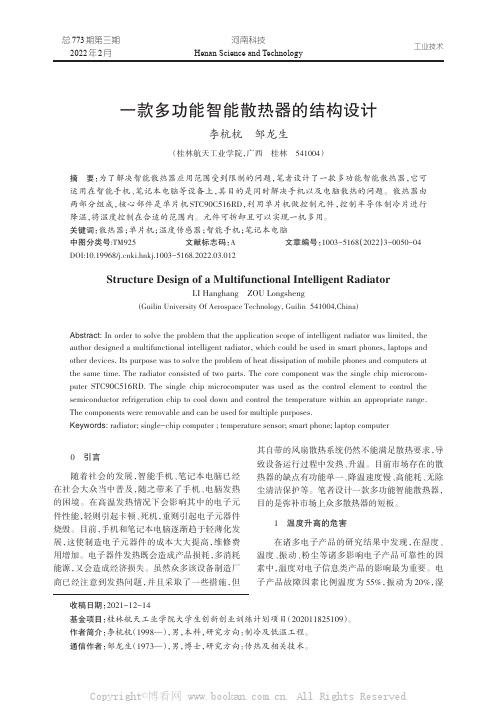
河南科技Henan Science and Technology 工业技术总773期第三期2022年2月一款多功能智能散热器的结构设计李杭杭邹龙生(桂林航天工业学院,广西桂林541004)摘要:为了解决智能散热器应用范围受到限制的问题,笔者设计了一款多功能智能散热器,它可运用在智能手机、笔记本电脑等设备上,其目的是同时解决手机以及电脑散热的问题。
散热器由两部分组成,核心部件是单片机STC90C516RD,利用单片机做控制元件,控制半导体制冷片进行降温,将温度控制在合适的范围内。
元件可拆卸且可以实现一机多用。
关键词:散热器;单片机;温度传感器;智能手机;笔记本电脑中图分类号:TM925文献标志码:A文章编号:1003-5168(2022)3-0050-04 DOI:10.19968/ki.hnkj.1003-5168.2022.03.012Structure Design of a Multifunctional Intelligent RadiatorLI Hanghang ZOU Longsheng(Guilin University Of Aerospace Technology,Guilin541004,China)Abstract:In order to solve the problem that the application scope of intelligent radiator was limited,the author designed a multifunctional intelligent radiator,which could be used in smart phones,laptops and other devices.Its purpose was to solve the problem of heat dissipation of mobile phones and computers at the same time.The radiator consisted of two parts.The core component was the single chip microcom⁃puter STC90C516RD.The single chip microcomputer was used as the control element to control the semiconductor refrigeration chip to cool down and control the temperature within an appropriate range. The components were removable and can be used for multiple purposes.Keywords:radiator;single-chip computer;temperature sensor;smart phone;laptop computer0引言随着社会的发展,智能手机、笔记本电脑已经在社会大众当中普及,随之带来了手机、电脑发热的困境。
笔记本电脑散热器的设计分析
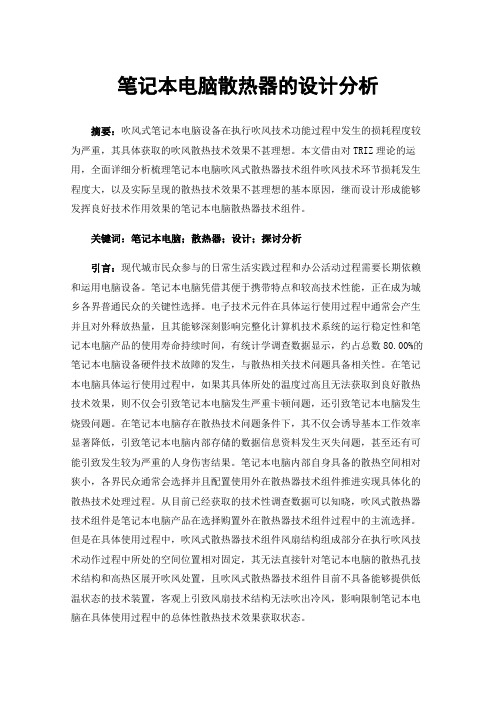
笔记本电脑散热器的设计分析摘要:吹风式笔记本电脑设备在执行吹风技术功能过程中发生的损耗程度较为严重,其具体获取的吹风散热技术效果不甚理想。
本文借由对TRIZ理论的运用,全面详细分析梳理笔记本电脑吹风式散热器技术组件吹风技术环节损耗发生程度大,以及实际呈现的散热技术效果不甚理想的基本原因,继而设计形成能够发挥良好技术作用效果的笔记本电脑散热器技术组件。
关键词:笔记本电脑;散热器;设计;探讨分析引言:现代城市民众参与的日常生活实践过程和办公活动过程需要长期依赖和运用电脑设备。
笔记本电脑凭借其便于携带特点和较高技术性能,正在成为城乡各界普通民众的关键性选择。
电子技术元件在具体运行使用过程中通常会产生并且对外释放热量,且其能够深刻影响完整化计算机技术系统的运行稳定性和笔记本电脑产品的使用寿命持续时间,有统计学调查数据显示,约占总数80.00%的笔记本电脑设备硬件技术故障的发生,与散热相关技术问题具备相关性。
在笔记本电脑具体运行使用过程中,如果其具体所处的温度过高且无法获取到良好散热技术效果,则不仅会引致笔记本电脑发生严重卡顿问题,还引致笔记本电脑发生烧毁问题。
在笔记本电脑存在散热技术问题条件下,其不仅会诱导基本工作效率显著降低,引致笔记本电脑内部存储的数据信息资料发生灭失问题,甚至还有可能引致发生较为严重的人身伤害结果。
笔记本电脑内部自身具备的散热空间相对狭小,各界民众通常会选择并且配置使用外在散热器技术组件推进实现具体化的散热技术处理过程。
从目前已经获取的技术性调查数据可以知晓,吹风式散热器技术组件是笔记本电脑产品在选择购置外在散热器技术组件过程中的主流选择。
但是在具体使用过程中,吹风式散热器技术组件风扇结构组成部分在执行吹风技术动作过程中所处的空间位置相对固定,其无法直接针对笔记本电脑的散热孔技术结构和高热区展开吹风处置,且吹风式散热器技术组件目前不具备能够提供低温状态的技术装置,客观上引致风扇技术结构无法吹出冷风,影响限制笔记本电脑在具体使用过程中的总体性散热技术效果获取状态。
《2024年双进双出射流水冷大功率LED散热系统设计》范文

《双进双出射流水冷大功率LED散热系统设计》篇一一、引言随着LED技术的不断发展,大功率LED照明产品已经广泛应用于各种领域。
然而,大功率LED在运行过程中会产生大量的热量,如果不能及时有效地进行散热,将会严重影响其使用寿命和性能。
因此,设计一款高效、可靠的散热系统对于大功率LED 照明产品的性能和寿命至关重要。
本文将介绍一种双进双出射流水冷大功率LED散热系统的设计,旨在提高LED的散热效率,保证其稳定、长久地运行。
二、系统设计概述双进双出射流水冷大功率LED散热系统采用双进口双出口的冷却液循环方式,通过高效的散热器将LED产生的热量迅速传递并散出。
该系统主要包括进水口、出水口、散热器、水泵、水箱、管道及控制系统等部分。
三、设计思路及特点1. 双进双出结构双进双出结构通过增加散热液流的流动通道和速度,使得热交换效率得到提高。
此外,通过多通道、多层次的散热器结构,实现大面积、高效的散热效果。
2. 流水冷技术采用流水冷技术,通过冷却液在散热器内部循环流动,将热量从LED芯片传递至散热器表面,再通过散热器与外界空气的对流和辐射作用将热量散出。
这种技术具有散热效果好、噪音低等优点。
3. 高效散热器设计散热器采用高导热材料,通过多层次、多通道的结构设计,增大散热面积,提高散热效率。
同时,优化散热器的鳍片形状和间距,以降低风阻,提高散热效果。
4. 智能控制系统智能控制系统能够实时监测LED的工作状态和温度,根据实际情况自动调节水泵的转速和冷却液的流量,以保证LED始终处于最佳的工作状态。
此外,控制系统还具有故障诊断和保护功能,确保系统的稳定性和可靠性。
四、系统组成及工作原理1. 进水口和出水口进水口和出水口分别连接水泵和水箱,通过水泵的驱动使冷却液在系统中循环流动。
进水口处设有过滤器,防止杂质进入系统影响散热效果。
2. 水泵和水箱水泵负责驱动冷却液在系统中循环流动,保证散热器始终处于最佳的工作状态。
水箱则负责储存冷却液,保证系统的正常运行。
- 1、下载文档前请自行甄别文档内容的完整性,平台不提供额外的编辑、内容补充、找答案等附加服务。
- 2、"仅部分预览"的文档,不可在线预览部分如存在完整性等问题,可反馈申请退款(可完整预览的文档不适用该条件!)。
- 3、如文档侵犯您的权益,请联系客服反馈,我们会尽快为您处理(人工客服工作时间:9:00-18:30)。
智能散热器的设计学生姓名:学生学号:院(系):电气信息工程学院年级专业:电子信息工程指导教师:助理指导教师:二〇一五年五月摘要转换效率是我们在生活中最看重的,能把物质利用到最大化。
能量大部分都被消耗在热能,所以提高散热是最为关键。
智能散热器的设计是为了满足在开关电源中提高开关管效率进行需求而做的课题,具有较为广阔的市场前景。
本文介绍智能散热器的设计是针对开关电源中开关管散热而设计开发工作。
在电源设计中散热决定了该电源的稳定性与可靠性。
智能散热器整体设计是围绕低成本,模块化,可扩展和寿命长的特点。
单片机采集功率器件的环境温度进而去控制风扇的旋转,并能自动根据温度的变化调整转速,在现实中有着非常广泛的应用,该智能散热器系统可广泛应用于开关电源而设计,完全脱离人工操作,并可以通过远程监视、控制,真正实现了智能控制,目前已经在极高压电源上系统中使用。
关键词:PWM,单片机,智能系统,温度控制ABSTRACTThe conversion efficiency is our most valued in life, can make to maximize the material utilization. Most of the energy is consumed in the heat, so as to improve the heat dissipation is the key. The design of intelligent radiator is to meet the increasing demand for the switch efficiency of the project in the switching power supply, has a broad market prospect.This paper introduces the design of intelligent radiator is designed for the development of the heat pipe switch in a switching power supply work. In thedesign of power supply cooling determines the stability and reliability of the power supply. The overall design of intelligent radiator is around the low cost, modular, extensible and long service life. The single-chip power device and the ambient temperature to control the rotation of the fan, and can automatically adjust the speed according to the change of temperature, there is a very wide range of applications in reality.Widely used in switching power supply and design of the intelligent radiator system, without manual operation, and can be controlled by remote monitoring, and realize intelligent control, has been used in high voltage power supply system on.Key words PWM Single chip microcomputer temperature control目录摘要.................................................................................................................................. I ABSTRAC T....................................................................................................................... I I1绪论 (1)1.1 课题背景 (1)1.2 国内外研究现状、水平 (1)1.3 本课题的发展趋势 (2)2 方案论证与选择 (3)2.1系统的设计要求及主要技术指标 (3)2.2系统总体设计方案 (3)2.3系统总体设计方案论述 (4)2.4系统软件设计方案分析 (4)3 系统的硬件设计 (5)3.1单片机的选择与其性能分析 (5)3.1.1 单片机概述 (5)3.1.2 单片机STC89C54的介绍 (5)3.1.3 开关电源散热器设计方法 (8)3.1.4 单片机晶振电路 (9)3.1.5单片机复位电路 (10)3.2传感器的选择与其性能分析 (11)3.2.1方案论证: (11)3.2.2温度传感器DS18B20简介 (12)3.2.3 DS18B20内部结构 (12)3.2.4 DS18B20温度传感器的存储器 (13)3.3数据采集电路的设计 (15)3.4转速模块控制设计 (15)3.4.1直流电机转速调节原理 (15)3.4.2电机调速控制方案论证 (16)3.4.3 PWM方式选择 (16)3.4.4 传感器放置位置的选择 (17)3.5开关管如何散热的论述 (18)3.5.1电机驱动方案选择 (18)3.5.2 L298驱动芯片 (18)3.5.3 电机及驱动模块电路连接 (20)3.6温度显示模块设计 (21)3.6.1显示模块的简述 (21)3.6.2液晶显示模块的电路连接 (22)4 软件设计 (24)4.1 系统软件构架 (24)4.2 18B20读取程序 (27)5 仿真设计与结果分析 (28)5.1 仿真软件的简介 (28)5.1.1 仿真软件Proteus的简介 (28)5.1.2 keil uVision4编程开发工具的简介 (29)5.2本系统的Proteus仿真设计 (29)6 PCB设计 (32)6.1 PCB设计软件简介 (32)6.2 PCB的EMC设计 (33)6.2.1 元器件布局的基本原则 (33)6.2.2 布线设计原则 (33)6.2.3 印制电路板制作流程 (34)7 组装与调试 (36)7.1系统组装 (36)7.2硬件调试 (36)7.3软件调试 (37)7.4硬件软件联合调试 (37)结论 (38)参考文献 (39)附录A:智能散热器的设计源程序代码 (41)附录B:整体原理图 (51)附录C:整体仿真电路图 (52)附录D:整体实物图 (54)致谢.................................................................................................. 错误!未定义书签。
1绪论1.1 课题背景散热器在我们生活和工业中随处可见,但是大部分都是比较单一的,智能散热器在工业生产、日常生活中都有广泛的应用,本文主要讲开关电源中对开关管进行温度的变化实时散热。
为了使开关电源能够正常工作,需要安装合适的散热器开关集成电路,为了便于内部开关和数字芯片及时降低温度,避免造成开关管(MOSFET)的节点温度过高,以致开关电源不能正常工作,甚至整个开关的DS两端直接短路损坏。
它决定了整个电源及其设计可持续的工作稳定性。
特别是在高压电源中的大功率开关管中需要大量散热,所以开关的散热问题需要重视,散热没有得到很好的解决,所以本课题就是考虑在高压开关电源中开关管的散热中做出的论述。
本设计可以作为一个简单的控制来实现复杂的控制,使控制电压的变化,从而进行快速温度变化控制,为今后复杂控制设计的基础。
1.2 国内外研究现状、水平微管到散热器:是运用当前最先进的电子封装技术以及工艺,在电子元器件内部刻上非常细微的冷却流液通管道。
但是这个技术现在只是出于实验测试阶段,因为对电子元器件的封装工艺要求十分严格所以限制了其实现的应用,但是在不久的将来是应该会有长足的发展。
在国外任何行业都在解决散热问题,尽量把损耗热量降低到最低,但是事实上很难显示,一般的解决方法就是在大功率的元器件上加个散热片,大多数的散热片都是铝合金材料,然后在根据功大率电子元器件的大小,在加工成需要的。
但是某些用途上加工的散热片的结构是很大的难度,结构较复杂,并且笨重,不利于在航空航天上运用。
在航空航天的领域中很多很多都是采用风冷的散热器,有点就是能反馈温度信息,比较简单和轻巧。
美欧等冷散热器逐渐向标准化,系列化,模块化方面发展,智能散热器的设计已经有了一定的成效,可以使智能散热器根据环境的温度的变化进行自动无级调速,当温度升高到一定时能自动启动电机转动使其降温的作用,实现远程控制。
智能散热器以广泛用于工业控制和生活当中。
纳米流体强化传热研究:研究表明,在液体传热介质可显著提高液体导热系数的一种纳米颗粒。
温度测控技术包括温度测量技术和温度控制技术两方面。
在温度的测量技术中,接触式。
1.3 本课题的发展趋势随着技术的进步,智能散热器将会在开关电源中得到进一步的发展,不断提高其智能控制的精确度,不断的降低其运转的噪音,甚至实现零噪音,不断的降低功耗以节能,以及充分提高开关电源中的集成度使其嵌入设备中将是其发展的趋势。
不管在高压和低压电源中,散热问题还需要不断的改进与提高,降低开关管的损坏,让工作更稳定,在现在很多领域上散热这个问题还需要好好的解决。
如果把散热问题尽量的降低到最大化,就是把损耗的热能降到更低,那就可以更好的提高转换效率了。
本课题是采用物理方法强迫空气加速流动,方法简单,可靠。
在开关电源中可以更好的尝试用这中方法,在未来的产品中可以用到此技术。
在现在的散热中就是在开关管中加散热片,或者水冷的方式。
首先加散热片的方式,它的缺点就是体检大,在安装产品中结构需要考虑,也许体检就会更大,并且材料不好买,加工复杂;其次就是水冷的方式,效果比较不错,但是成本更高,结构更复杂,所以通过以上的论述,在开关上加风扇和散热片相结合相对比较合适。
在未来的开关电源设计中,肯定是考虑的一个方法。
现在的散热的方式就这几种,其中及分为:自然冷却散热,风冷散热,液冷散热。
